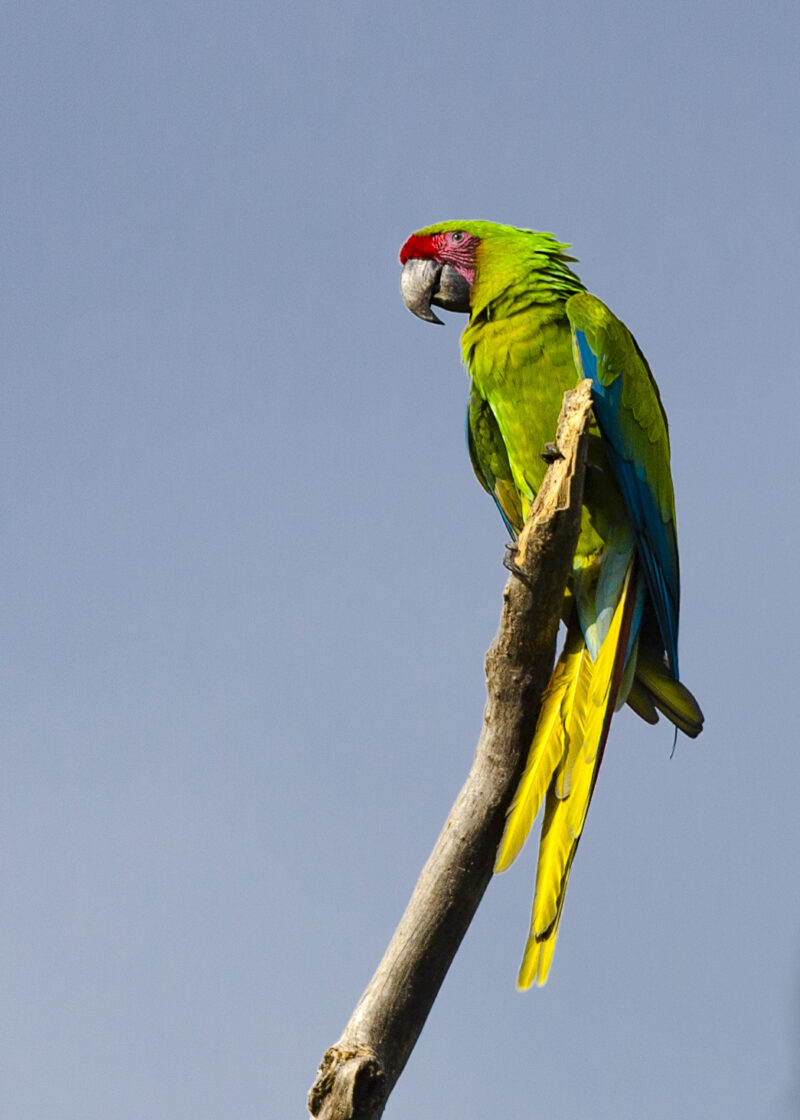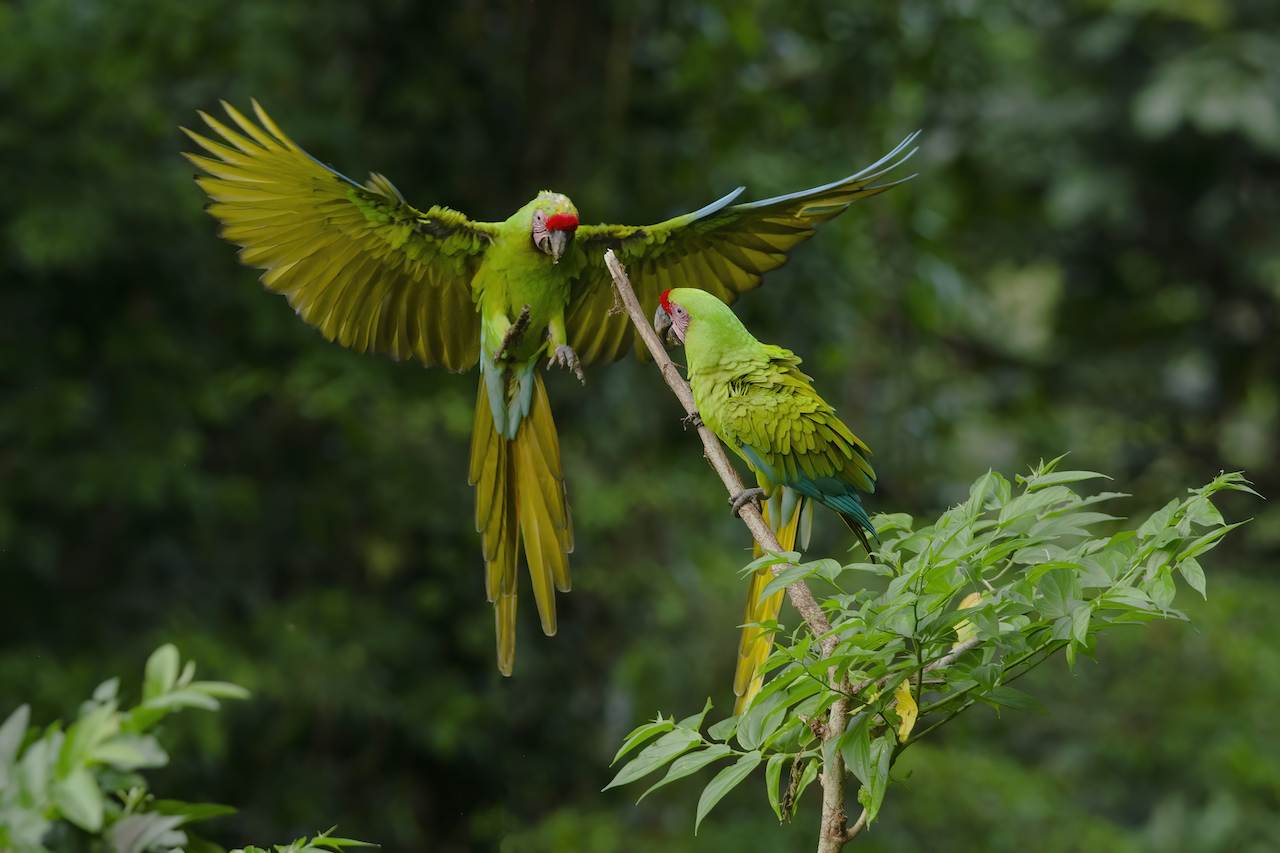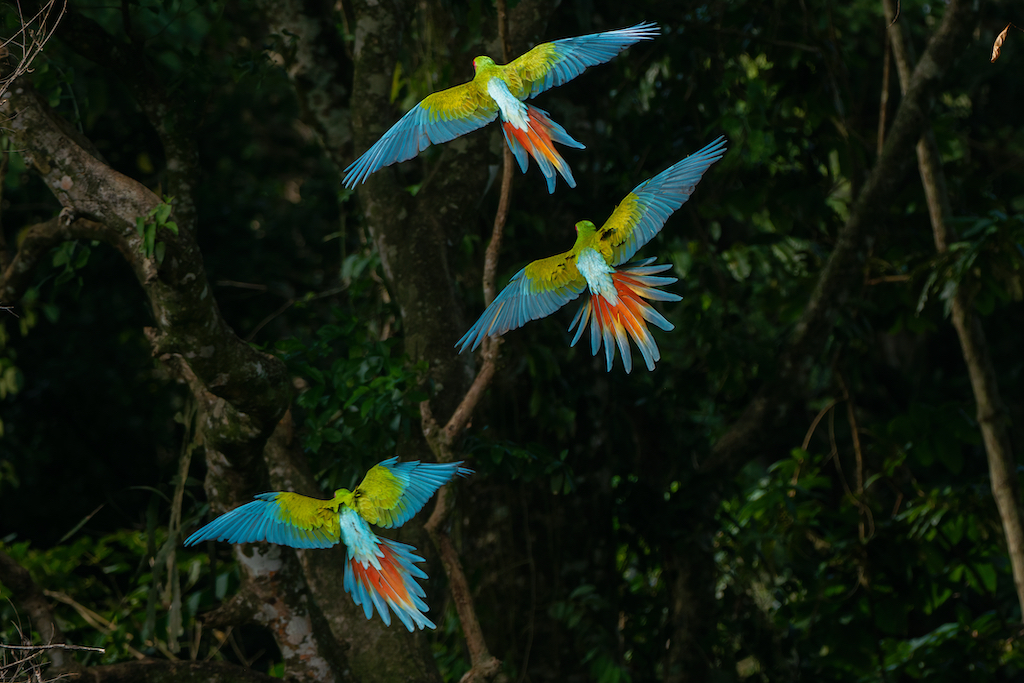The Great Green Macaw

KINGDOM: Animalia
PHYLUM: Chordata
CLASS: Birds
ORDER: Psittaciforms
FAMILY: Psittacidae
GENUS: Ara
SPECIES: Ara ambiguus
Highlights.
Population size: 500-1,000
Life span: 60-70 YRS
Weight: 1.3 KG
Length: 85-90 CM
The great green macaw (Ara ambiguus), is a Central and South American parrot found in Nicaragua, Honduras, Costa Rica, Panama, Colombia and Ecuador. Two allopatric subspecies are recognized; the nominate subspecies, Ara ambiguus ssp. ambiguus, occurs from Honduras to Colombia, while Ara ambiguus ssp. guayaquilensis appears to be endemic to remnants of dry forests on the southern Pacific coast of Ecuador. The nominate subspecies lives in the canopy of wet tropical forests and in Costa Rica is usually associated with the almendro tree (Dipteryx oleifera).
Appearance
Great green macaws are the largest parrots in their natural range. They are mainly green in color and have a reddish forehead and pale blue lower back, rump, and upper tail feathers. The tail is brownish-red tipped with very pale blue. The bare facial skin is patterned with lines of small dark feathers, which are reddish in older and female parrots. Juveniles have gray-colored eyes instead of black, are duller in color, and have shorter tails that are tipped in yellow.
Distribution:
South America,Central America
Countries:
Costa Rica, Ecuador, Honduras, Nicaragua, Panamá
Biogeographical realms
Neotropical
WWF biomes
Tropical dry forest, Tropical moist forests

Habits and Lifestyle
Great green macaws are diurnal and social birds. They are usually seen in pairs or small groups of up to four to eight individuals, very rarely more. In Costa Rica, after the breeding season, Great green macaws gather in flocks and migrate towards the coasts in search of food. In Costa Rica, these flocks usually consist of up to 18 birds. Great green macaws are arboreal; they rest and forage in the upper areas of the canopy. These are very noisy birds especially when in flight and their extremely loud, raucous "aak, raak" can be heard at great distances.
Group name:
flock, company, pandemonium
Lifestyle:
Arboreal, Altricial, Oviparous
Seasonal Behavior:
Not a migrant
Diet and Nutrition
Great green macaws are herbivores (frugivores, granivores). They feed on seeds, nuts, and fruits, but also flowers, bulbs, roots, and bark.

Mating Habits
Mating behavior: monogamy
Reproduction season: december-june in costa rica; august-october in ecuador
Incubation period: 26 days
Independent age: 18-20 weeks
Female name: hen
Male name: cock
Ibaby name: chick
Web animal clutch size:
2-3 eggs
Great green macaws are monogamous and form strong pair bonds for life. Their breeding season starts in December and ends in June in Costa Rica, and from August to October in Ecuador. Pairs nest in cavities high up in the trunk, near the crown of the tree. The female lays a clutch of 2-3 eggs and incubates them for 26 days. Chicks hatch weighing 23g, can fly after 12-13 weeks and are weaned after 18-20 weeks when they weigh over 900g. After fledging juveniles stay with their parents as a family unit for a significant amount of time, only separating gradually from them. Young birds, at least in captivity, become mature after 5 years and start breeding after 6 or 7 years.
Population threats
The main threat to the survival of the Great green macaw was habitat loss. It is estimated that between 1900 and 2000 some 90% of the original habitat has been lost in Costa Rica. Private land not owned by the government is or has been developed into agricultural fields for the production of crops such as oil palm, pineapples, and bananas. As of 2015 Indio-Maíz Biological Reserve in Nicaragua is threatened by settlers moving into the reserve to found farms, especially for subsidence agriculture, oil palm, and cattle. Other threats have included hunting pressure for sport and feathers and the pet trade. In some areas, Great green macaws are considered pests on maize cultivation and are persecuted for that reason. They have also been killed for food.
Population number
According to the IUCN Red List, the total Great green macaw population size is around 500-1,000 mature individuals. Currently, this species is classified as Critically Endangered (CR) on the IUCN Red List and its numbers today are decreasing.
Ecological niche
Due to their diet habits, Great green macaws may act as seed dispersers; they distribute seeds from various fruits, particularly the almond tree (Almendro), which these birds are fond of the most.
Some other quick facts.
● The Great green macaw belongs to the genus Ara, which includes other large parrots, such as the Scarlet macaw, the Military macaw, and the Blue-and- yellow macaw.
● The Great green macaw looks very similar to the Military macaw and where their ranges overlap these two birds may easily be confused.
● Macaws have dry scaly tongues with a bone inside them which they use to eat fruits.
● Macaws form such strong pair bonds that even when the pair flies with a large flock, the birds keep close to each other and almost touch their wings in flight.
● When macaws wake up in the morning, they preen their feathers and call to one another, perhaps checking where they are and what they are going to do
next.
Reference link
